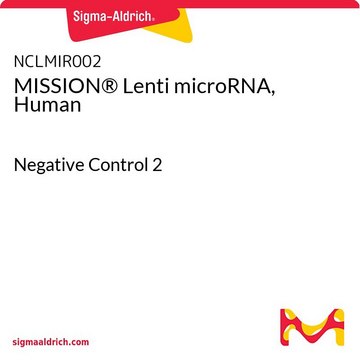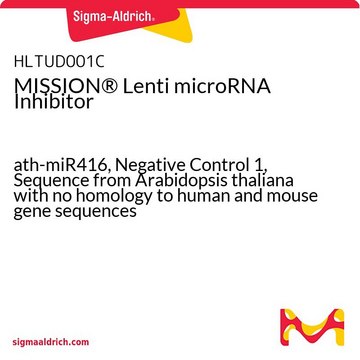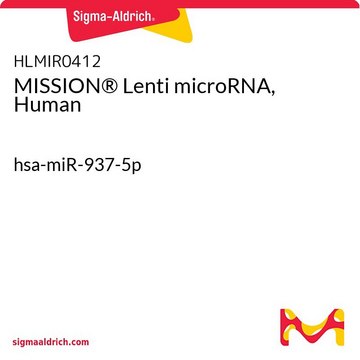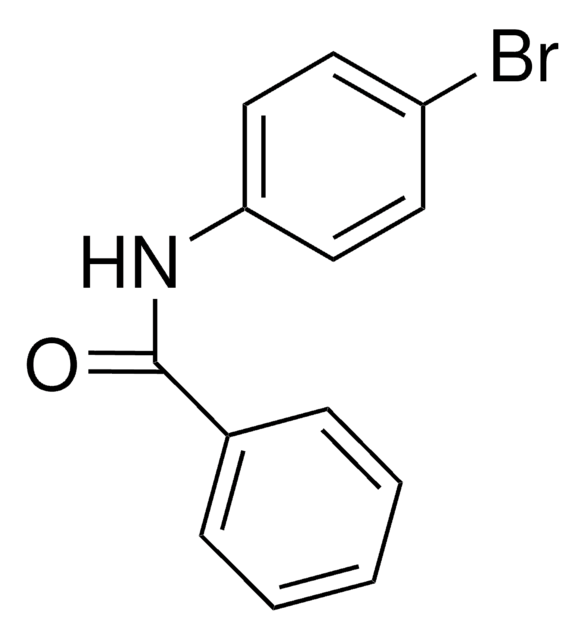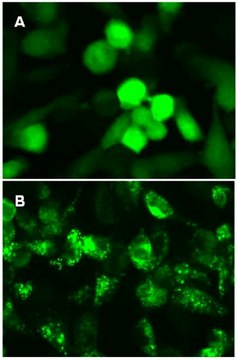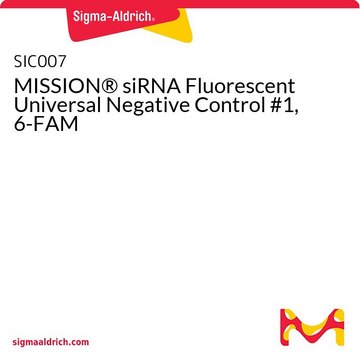NCLMIR001
MISSION® Lenti microRNA, Human
Negative Control 1
Sign Into View Organizational & Contract Pricing
All Photos(1)
About This Item
UNSPSC Code:
41106609
NACRES:
NA.51
Recommended Products
Quality Level
product line
MISSION®
form
liquid
concentration
≥1x106 VP/ml (via p24 assay)
shipped in
dry ice
storage temp.
−70°C
General description
Sigma′s Mission Lenti-miRs express miRNAs from a common backbone, whose structure meets requirements for accurate Dicer processing and a partially complementary strand is designed to mimic the base pairing pattern in the backbone structure using a proprietary algorithm. Oligos containing the microRNA sequences are cloned into the TRC2-pLKO-puro vector. Each miRNA construct has been cloned and sequence verified. Mature microRNA sequences are obtained from miRBase.
Lentiviral transduction particles are produced from sequence-verified lentiviral plasmid vectors. Oligos containing the microRNA sequences are cloned into the TRC2-pLKO-puro vector. Co-transfection of this vector into the appropriate cell line with compatible packaging plasmids produces viral particles that can be used to transduce mammalian cells. The polymerase II promoter, elongation factor 1 alpha (EF1A), was chosen to drive miRNA expression needed for reverse transcription of viral RNA and integration of viral DNA into the host cell genome. Additionally, the Woodchuck Hepatitis Post-Transcriptional Regulatory element allowing for enhanced expression of transgenes delivered by lentiviral vectors. This lentiviral vector also carries a puromycin resistance gene for selection of cells. Unlike murine-based MMLV or MSCV retroviral systems, lentiviral-based particles permit efficient infection and integration of the specific miRNA construct into differentiated and non-dividing cells, such as neurons and dendritic cells.
Lentiviral transduction particles are produced from sequence-verified lentiviral plasmid vectors. Oligos containing the microRNA sequences are cloned into the TRC2-pLKO-puro vector. Co-transfection of this vector into the appropriate cell line with compatible packaging plasmids produces viral particles that can be used to transduce mammalian cells. The polymerase II promoter, elongation factor 1 alpha (EF1A), was chosen to drive miRNA expression needed for reverse transcription of viral RNA and integration of viral DNA into the host cell genome. Additionally, the Woodchuck Hepatitis Post-Transcriptional Regulatory element allowing for enhanced expression of transgenes delivered by lentiviral vectors. This lentiviral vector also carries a puromycin resistance gene for selection of cells. Unlike murine-based MMLV or MSCV retroviral systems, lentiviral-based particles permit efficient infection and integration of the specific miRNA construct into differentiated and non-dividing cells, such as neurons and dendritic cells.
Recommended products
Two negative controls are available: NCLMIR001 and NCLMIR002
Legal Information
MISSION is a registered trademark of Merck KGaA, Darmstadt, Germany
Storage Class Code
12 - Non Combustible Liquids
WGK
WGK 3
Flash Point(F)
Not applicable
Flash Point(C)
Not applicable
Regulatory Information
新产品
Choose from one of the most recent versions:
Certificates of Analysis (COA)
Lot/Batch Number
Don't see the Right Version?
If you require a particular version, you can look up a specific certificate by the Lot or Batch number.
Already Own This Product?
Find documentation for the products that you have recently purchased in the Document Library.
Lei Zhang et al.
Biomedicine & pharmacotherapy = Biomedecine & pharmacotherapie, 107, 424-432 (2018-08-14)
MicroRNAs (miRNAs) regulate a variety of development and physiologic processes, and play prominent roles in the initiation and progression of human cancers including hepatocellular carcinoma (HCC). MiR-23c is recently emerging as a cancer-associated miRNA, while its expression status and functional
Liang Bao et al.
Journal of biosciences, 42(4), 671-681 (2017-12-13)
Lung cancer is the leading cause of cancer-related death throughout the world. We aimed to investigate the role of a novel microRNA-876-5p and its potential molecular target bone morphogenetic protein 4 (BMP-4), in the epithelial-mesenchymal transition (EMT) of lung cancer.
Our team of scientists has experience in all areas of research including Life Science, Material Science, Chemical Synthesis, Chromatography, Analytical and many others.
Contact Technical Service
